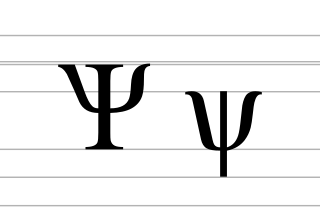
An alphabet is a standard set of letters written to represent particular sounds in a spoken language. Specifically, letters largely correspond to phonemes as the smallest sound segments that can distinguish one word from another in a given language. Not all writing systems represent language in this way: a syllabary assigns symbols to spoken syllables, while logographies assign symbols to words, morphemes, or other semantic units.
Gamma is the third letter of the Greek alphabet. In the system of Greek numerals it has a value of 3. In Ancient Greek, the letter gamma represented a voiced velar stop IPA:[ɡ]. In Modern Greek, this letter normally represents a voiced velar fricative IPA:[ɣ], except before either of the two front vowels, where it represents a voiced palatal fricative IPA:[ʝ]; while /g/ in foreign words is instead commonly transcribed as γκ).

X, or x, is the twenty-fourth letter of the Latin alphabet, used in the modern English alphabet, the alphabets of other western European languages and others worldwide. Its name in English is ex, plural exes.
Xi is the fourteenth letter of the Greek alphabet, representing the voiceless consonant cluster. Its name is pronounced in Modern Greek. In the system of Greek numerals, it has a value of 60. Xi was derived from the Phoenician letter samekh .
Zeta is the sixth letter of the Greek alphabet. In the system of Greek numerals, it has a value of 7. It was derived from the Phoenician letter zayin . Letters that arose from zeta include the Roman Z and Cyrillic З.

The Russian alphabet is the script used to write the Russian language. It is derived from the Cyrillic script, which was modified in the 9th century to capture accurately the phonology of the first Slavic literary language, Old Slavonic. Initially an old variant of the Bulgarian alphabet, it was used in Kievan Rus' from the 10th century onward to write what would become the modern Russian language.

The Early Cyrillic alphabet, also called classical Cyrillic or paleo-Cyrillic, is an alphabetic writing system that was developed in Medieval Bulgaria in the Preslav Literary School during the late 9th century. It is used to write the Church Slavonic language, and was historically used for its ancestor, Old Church Slavonic. It was also used for other languages, but between the 18th and 20th centuries was mostly replaced by the modern Cyrillic script, which is used for some Slavic languages, and for East European and Asian languages that have experienced a great amount of Russian cultural influence.

Kha, Khe, Xe or Ha is a letter of the Cyrillic script. It looks the same as the Latin letter X, in both uppercase and lowercase, both roman and italic forms, and was derived from the Greek letter Chi, which also bears a resemblance to both the Latin X and Kha.

Che, Cha or Chu is a letter of the Cyrillic script.

The Ukrainian alphabet is the set of letters used to write Ukrainian, which is the official language of Ukraine. It is one of several national variations of the Cyrillic script. It comes from the Cyrillic script, which was devised in the 9th century for the first Slavic literary language, called Old Slavonic. In the 10th century, Cyrillic script became used in Kievan Rus' to write Old East Slavic, from which the Belarusian, Russian, Rusyn, and Ukrainian alphabets later evolved. The modern Ukrainian alphabet has 33 letters in total: 21 consonants, 1 semivowel, 10 vowels and 1 palatalization sign. Sometimes the apostrophe (') is also included, which has a phonetic meaning and is a mandatory sign in writing, but is not considered as a letter and is not included in the alphabet.

Psi is a letter in the early Cyrillic alphabet, derived from the Greek letter of the same name. It represents the sound /ps/, as in English naps. According to the school rules developed in the 16th and the 17th centuries, such as Meletius Smotrytsky's grammar book, it was intended for use in words of Greek origin, but it was occasionally used for writing native words as well like Ukrainian ѱы. It was used especially in words relating to the Eastern Orthodox Church, as can be seen in its continuing use in Church Slavonic.

Ksi is a letter of the Cyrillic script. It is a letter of the early Cyrillic alphabet, derived from the Greek letter Xi. It was mainly used in Greek loanwords, especially words relating to the Church.

Koppa is an archaic numeral character of the Cyrillic script. Its form are derived from some forms of the Greek letter Koppa (Ϙ ϙ).

The Romanian Cyrillic alphabet is the Cyrillic alphabet that was used to write the Romanian language & Church Slavonic until the 1860s, when it was officially replaced by a Latin-based Romanian alphabet. Cyrillic remained in occasional use until the 1920s, mostly in Russian-ruled Bessarabia.
U, or u, is the twenty-first letter of the English alphabet.
Željko Gavrilović is a Serbian former professional footballer who played as a forward.
Cyrillic is a Unicode block containing the characters used to write the most widely used languages with a Cyrillic orthography. The core of the block is based on the ISO 8859-5 standard, with additions for minority languages and historic orthographies.

B, or b, is the second letter of the Latin alphabet, used in the modern English alphabet, the alphabets of other western European languages and others worldwide. Its name in English is bee, plural bees.
Damir Muminovic is a professional footballer who plays as a defender for Besta deild karla club Breiðablik. Born in Serbia, he plays for the Iceland national team.











